Slowing Down to See the System: Lessons from the 2025 Banff Systems Summit
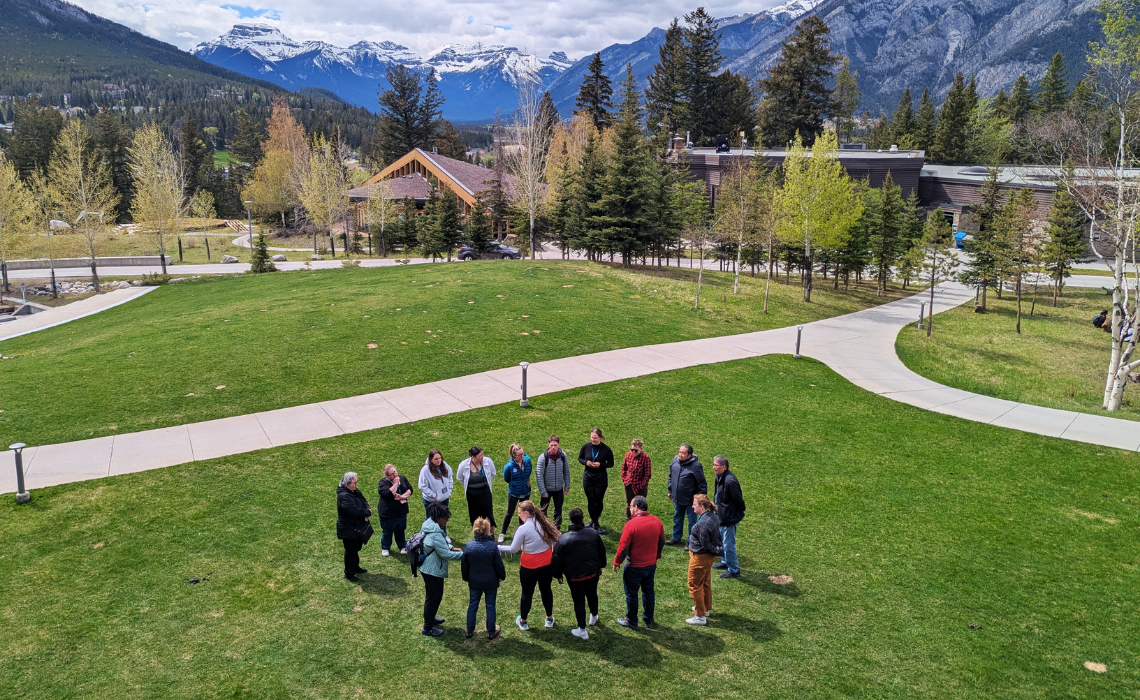
The road into Banff curves through a landscape that refuses to be rushed. Glacial peaks rise like old memories, the river folds into itself in a rhythm too slow for algorithms. It’s the kind of place that demands your full attention, with the body softening and the mind taking a deeper breath. The land doesn’t ask for efficiency. It asks for presence.
It was here that 165 thinkers, professionals, educators, students, elders, and artists gathered for the 2025 Banff Systems Summit to feel into complexity.
Dr. Leroy Little Bear opened the summit with a question that put us to the test over the course of the four days.
“If we want to talk about the sustainability of the human species, why aren’t we looking to the fish and asking for his wisdom?”
This was an invitation to move away from Western notions of control and toward an older way of knowing, where everything is animate, interrelated, and always becoming. A world where science is not detached observation, but a form of relationship. A world where systems thinking is a natural way of knowing and thinking. At its best, it is not about fixing our society. It’s about seeing it truly.
Systems Thinking: A Natural Way of Knowing, Slowly
“Existential dissonance is when we are complicit in systems that we disagree with”- Cassie Bingham.
Systems thinking has gained popularity again, particularly in light of the numerous sociopolitical issues that are currently gaining traction. You’ll hear it in TED Talks, grant proposals, boardrooms, and classrooms. However, we were encouraged to delve further here in Banff. To inquire: What kind of system are we trying to think into? And what kind of thinker does that system require?
The type of thinking that alters systems isn't quick, it turns out. It’s not clean. It doesn’t come from whiteboards or keynote clickers. It comes from sitting in discomfort. From naming grief. From listening without knowing what you’ll hear.
"We need to hospice old systems to birth new ones," said Katharine McGowan. "And for many, this will require a process of grieving and letting go. There is a liminal space between these two systems…a beautiful, creative space where anything can happen.”
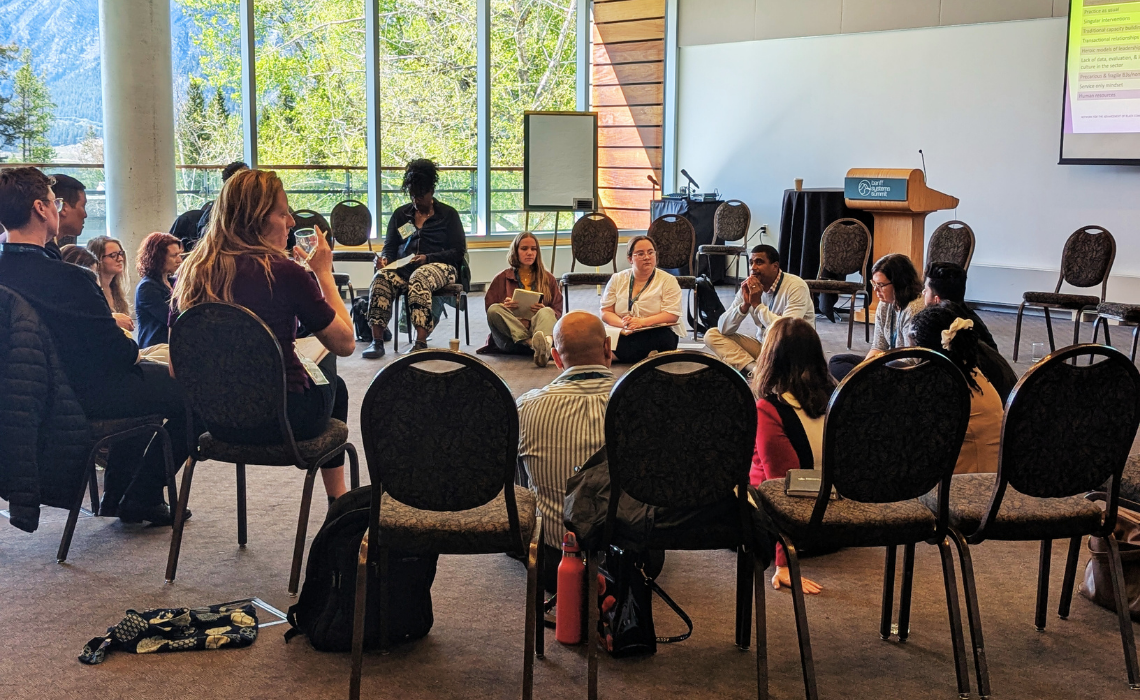
This idea of liminality, of sitting in the “in between”, surfaced again and again throughout the summit. Systems thinking is a practice of humility.
“The first step is embracing complexity. The second step is recognizing humility. I had to learn this the hard way when someone said to me: Listen, white man: problems aren't as simple as that. We can't just snap our fingers and solve things... That's how I discovered systems thinking.”- Nick Gregg
That humility showed up in the kinds of questions that hung in the air: Are good intentions enough? Can we shift systems without shifting power? What does it mean to release control?
As many Indigenous teachings remind us, time is not linear. It is cyclical, relational, and constantly unfolding. We are part of multiple futures. Our task is to keep showing up, to stay present, and to walk the path together.
“In these times of complex challenges,” said Daniela Papi-Thornton, “we need circular rather than linear leadership.”
Circular leadership, the kind that takes a long view, moves through relationships, and understands that forward isn’t always a straight line. There’s room to pause in circular leadership. To look around. To understand where you are before you try to move.
This shift, from heroic individualism to collective emergence, from expertise to listening, was highlighted. It was lived at the Banff Systems Summit. In breakout rooms, over tea, on the trails between sessions, participants shared moments of unlearning, of not knowing, of changing their minds.
“It’s not a time for heroic leadership; we need to move toward collective leadership models.”- Allan Boesak
And maybe that’s where systems transformation really begins, not with the answer, but with the pause before it; A willingness to sit with what is unresolved, to nudge rather than fix, to relate rather than control; when we pause long enough to notice what’s emerging between us.
“A sense of agency. Am I going to nudge the system somewhere else?”- A participant
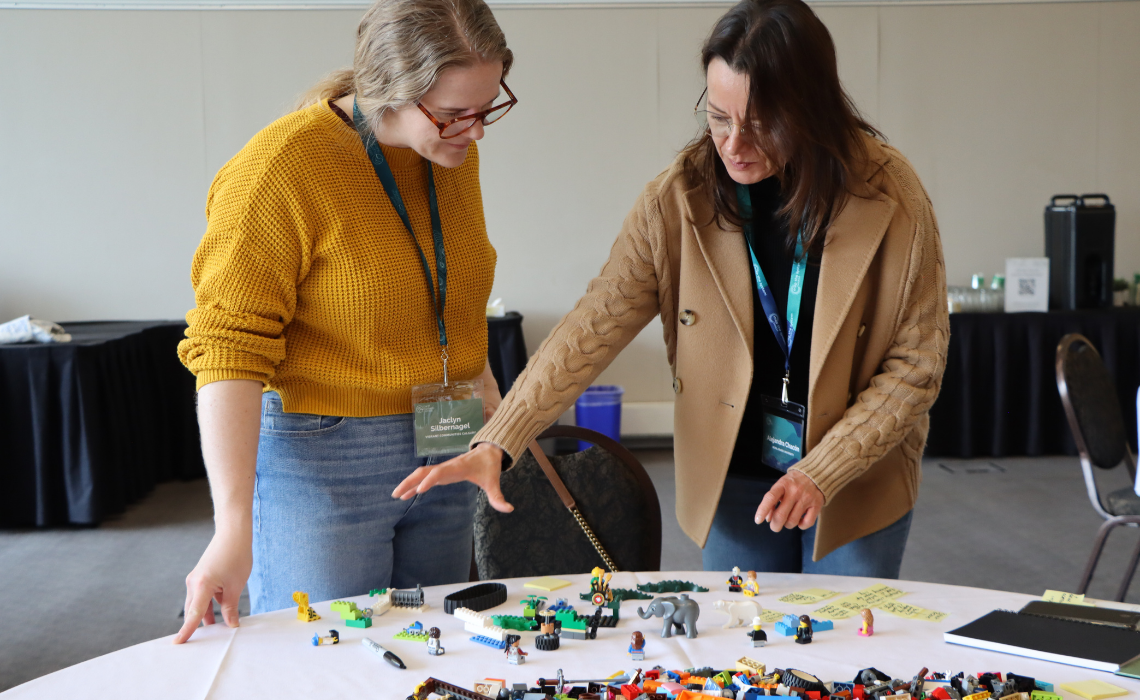
Slowing down, reflecting, and staying connected with one another, perhaps these are the ways we begin to nudge systems. As much as we keep saying we're doing “systems change” work, maybe it’s more honest to say we’re nudging systems—contributing, influencing, and shaping change from within. A nudge is a subtle shift, an influence on behaviour or decision-making by altering the environment in which choices are made. It isn’t coercive; people still choose freely, but the system gently guides them toward better outcomes.
The system is on a path, and we can nudge it in other directions.
This approach feels more grounded than dramatic change and helps normalize small shifts, because sometimes we can feel that we are not equipped enough for what is needed to really push the path. It allows for gradual, adaptive progress by embedding new values and norms in ways that feel organic.
“We're not responsible for full systems transformation. We can only do our own part and trust that others will take on other key parts of the change.”- Christine Spottiswood
Nudging embraces a system’s complexity. It’s flexible, resilient, and less likely to trigger resistance or unintended harm. Nudging creates space for small, meaningful interventions that build trust, shift culture, and move us forward, together.
And maybe that’s what systems work really asks of us now: less heroic, more humble. Less linear, more lived.
Let that be enough to begin again.
“We are committed to supporting community in perpetuity… for a generation we haven’t met yet.”- Tim Fox
Lessons from the Edge: Stories that Shift Systems
It is easy to talk about systems in the abstract. Their weight is more difficult to feel in your bones. Therefore, the narratives shared at the Banff Systems Summit were unvarnished, grounded, and lived experiences that helped us understand the systems. The real work of social change was shared in every room, and all of a sudden, the system was between us, here, rather than "out there."
Starting Where You Are: Place as Power
"Place-based partnerships need everyone. System change starts local."- Jaclyn Silbernagel
It started with a story about an apartment, not a place you'd expect transformation. During the height of the pandemic, the building had fallen quiet. Isolated. People stayed behind their doors, uncertain of one another.
Then someone left a note in the elevator: “Going for groceries. Need anything?”
That note evolved into borrowed phones, shared water cans, and a makeshift grocery corner in the hallway. One by one, neighbours stepped into small acts of care. A vertical tower slowly turned into a village.
This wasn’t a policy-level change. It wasn’t even “innovation.” It was a reminder: the system starts wherever your feet touch ground. And sometimes, that’s the most powerful place to begin.
"But we’ve never needed place more," added Lori Hewson. “It’s where we come together.”
Grieving the Old, Making Space for the New
"Decolonization requires grieving… you grieve that the work is hard and it needs to continue, because it took a long, long time.”- Evelyn Goodstriker
There was a stillness in the room when Evelyn Goodstriker spoke. Not the kind that asks for answers, but the kind that invites truth.
Reconciliation isn’t a checklist. It doesn’t unfold through task forces or tidy frameworks. It begins inside, in the quiet, often painful work of unlearning. It demands personal reckoning, alongside collective responsibility.
Some of that work happened in Reconciliation learning circles. They were not perfect, but they were honest. In those circles, people listened without fixing. Sat with discomfort without rushing through it. Held space for truths that didn’t match their own.
"Universities are uniquely positioned to create spaces where two worlds meet, where knowledge that isn’t traditionally credentialed can be recognized and valued.”- Zoe Say
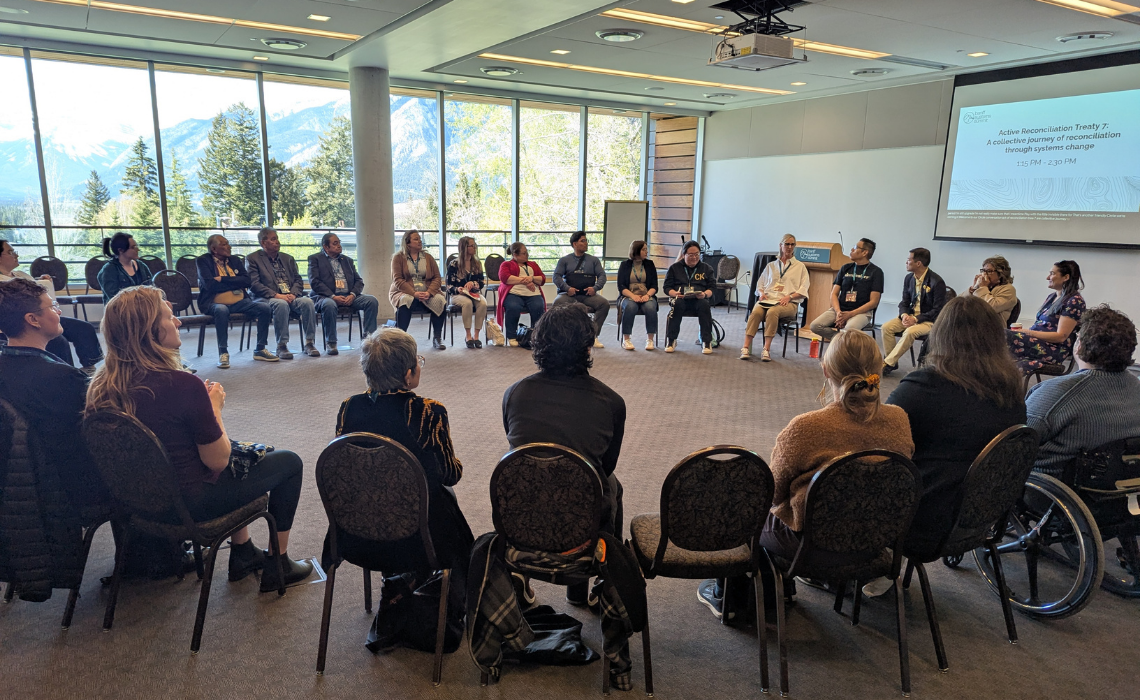
At Mount Royal University, those spaces are being shaped by people who hold power, not to control the narrative, but to open it. When authority makes space for those most affected, something shifts. The system begins to bend.
The process requires us to sit with discomfort, rather than bypass it. To question how systems like justice, education, and governance were designed, and whom they were designed for.
Reconciliation, we saw, is about staying present in the relationship.
Our task is to keep showing up.
"Reconciliation is most powerful when it’s recognized, practiced in relationships, and carried forward collectively.”- Tori McMillan
Science is Relationship
There’s something about a midlife crisis, whether personal or collective, that stops us in our tracks. It asks us: What are we doing? What have we built? What still makes sense?
One such current midlife crisis is COVID-19. That crisis spread through systems: health, education, justice, and governance. It cracked the surface of what we called “normal” and revealed what was broken underneath.
"We are in the collective midlife crisis.”- Dr. Leroy Little Bear
We were confronted with uncomfortable questions. What if the institutions we trusted don’t have all the answers? What if science itself, the foundation of so much modern progress, needs to evolve?
In his keynote, Dr. Leroy Little Bear didn’t argue against science, but he invited us on a journey with him to imagine a version of science rooted not in control, but in relationship.
"Western science is about control. Native science is about relationship. Western science is largely aimed at exploration. Native science is aimed at sustainablity.”- Dr. Leroy Little Bear
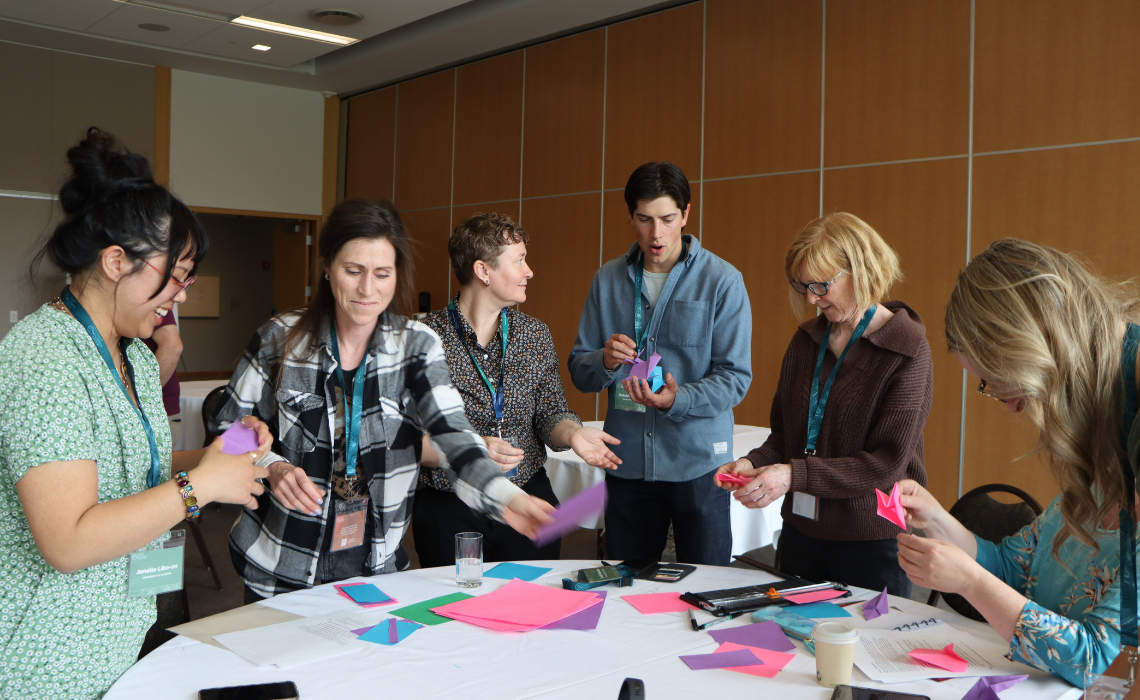
Western science, he explained, has been guided by the left brain, or known as logic, measurement, and categorization. It has helped us predict and explain the world in incredible ways. But it has also left little room for what can’t be plotted on a graph: spirit, emotion, experience, and interconnectedness.
Indigenous science, and particularly Blackfoot metaphysics, sees the world differently. Everything is animate. Everything is in motion. Language describes what things do, not what they are. Sustainability is not a policy goal but instead a way of being - being with the land, with ancestors, and with future generations.
“All my relations” isn’t just a phrase. It’s a worldview. A systems view with heart.”- Dr. Leroy Little Bear
When Western science asks, How does this work? Native science asks, How are we connected?
“Complexity isn’t about good vs evil or right vs wrong. In complexity nothing is good or bad, it just is. Maybe our job isn’t to label it, nor to fight it, but instead to ask questions about it, to find out what is contributing to the shifts”- Daniela Papi-Thornton
In this worldview, instead of being a tool to dominate nature, science is a way to understand our place within it. Science is relationship. If it doesn’t acknowledge or serve a relationship to the land, to each other, and to future generations, it isn’t truly science.
Take justice, for example. The Western system defines fairness in abstraction: equal treatment, standardized rules, and punishment for harm. But in a relational system, justice is restoration for support and healing.
“[In the family justice system], what families need isn’t punishment. It’s support, access, and healing.” - Diana Lowe
This is the difference between systems designed to control and systems designed to sustain.
And maybe, as Dr. Little Bear suggests, that’s the real crisis we’re facing, not just ecological or political, but epistemological. Our very frameworks of knowing are due for renewal.
For centuries, the power to define knowledge has been held by gatekeepers, first the church, then the monarchy, now often the academy. Each claimed authority over what counted as truth. But in a time of compounding crises, perhaps the most radical step forward is to rethink that authority.
Indeed, our next evolution is metaphysical.
Power and Partnership
Many of us at the Summit are familiar with a saying by Daniela Papi-Thornton “There isn’t a single way to start the system. There isn’t a single human who knows the answer.” And it’s true. No one is holding the full map. Each of us is working on a different part of the system, drawn to where we feel the tension, where we feel the hope, and where we feel empowered to act.
As much as we talk about systems change, the truth is, we rarely know exactly what it looks like from the start. What we do know is this: systems begin to shift when different ones of us in the communities start to “twitch,” when the spiderweb Ani-to-pi-si of change begins to vibrate.
And that twitch starts with changes in mindset, in muscle memory, and in how we hold and share power.
“There’s no right way to change systems. The only mistake is not to start.”- Temitope Ojo
Leading with Vulnerability
Diana Lowe told a story that many didn’t expect to hear, especially from someone who spent years inside Alberta’s family justice system.
She’d set out to improve it, to make it more just, and more accessible. But what she found was harder to accept: the system itself was causing harm.
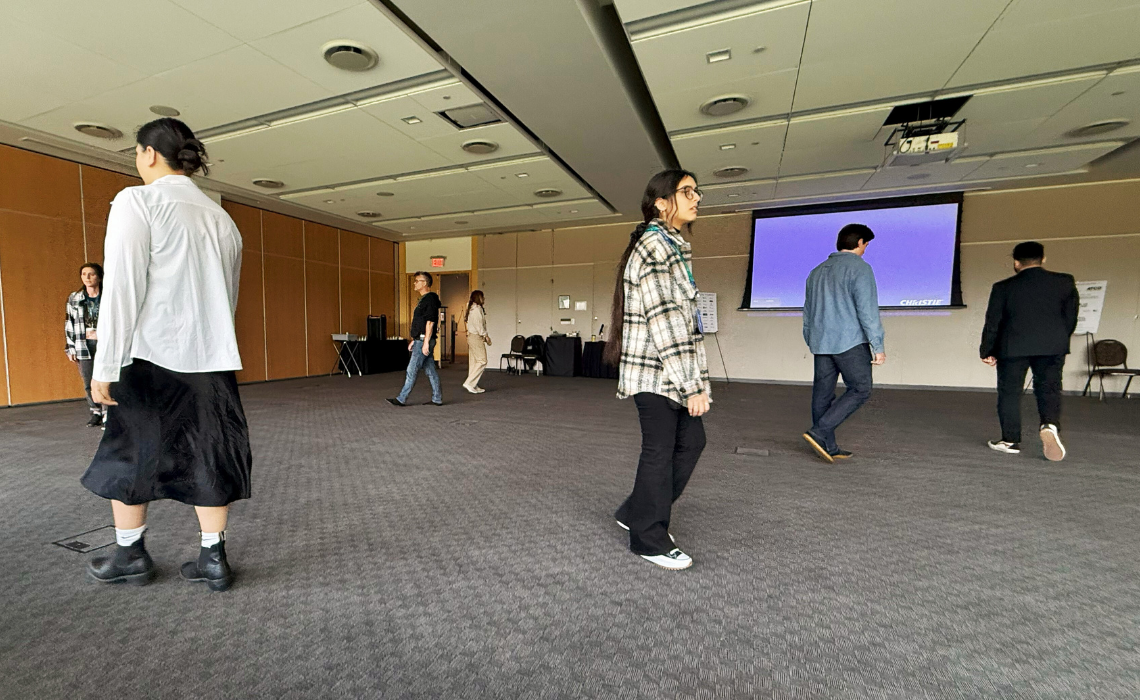
She wasn’t standing outside the problem trying to fix the systems. She was inside it. And inside, it became clear: The system wasn’t broken, it was working as designed. The system wasn’t at fault, nobody was at fault, because we did our parts. In fact, we were right all along about our roles. It’s just that the outcomes no longer matched the intent.
Therefore, that realization meant beginning again, with fewer assumptions and more humility. To change the systems is to lead differently, and that could mean leadership looks like stepping back. To slow down. To listen more than. And to let go of needing to have the answer.
“We need to create an atmosphere of situational leadership, not just fixed hierarchies.”- Nancy Southern
Nonprofits and Governments: Uneven Ground, Shared Goals
Shaun Loney also told us a story as a person who spent years inside government working as a civil servant. He knew the system intimately: its rules, its rituals, and its resistance to change. But like Diana Lowe, what he discovered over time wasn’t just inefficiency but also misalignment. The tools didn’t match the task. The incentives didn’t match the intention. And the people closest to community impact were too often kept furthest from power.
The nonprofit-government relationship, as many at the Summit reflected, is a dance between dependence and distance. Nonprofits are brought to the table for collaboration. Only until the conversation turns to funding, then the door quietly closes.
“Government is usually the financial beneficiary of nonprofit work, so why are nonprofits subsidizing the state?" - Shaun Loney
It’s a question that keeps surfacing because while nonprofits scramble for short-term grants and project-based funding, the real money or the kind tied to long-term contracts and scalable investment flows through procurement systems, where nonprofits are rarely at the table.
“Government funds what it wants. But it purchases what it doesn’t.”
This reveals something deeper of a system logic: Funding is used to manage problems. Procurement is used to commit to solutions.
And as long as nonprofits are kept at arm’s length from procurement, they stay reactive, even as they carry the weight of frontline service.
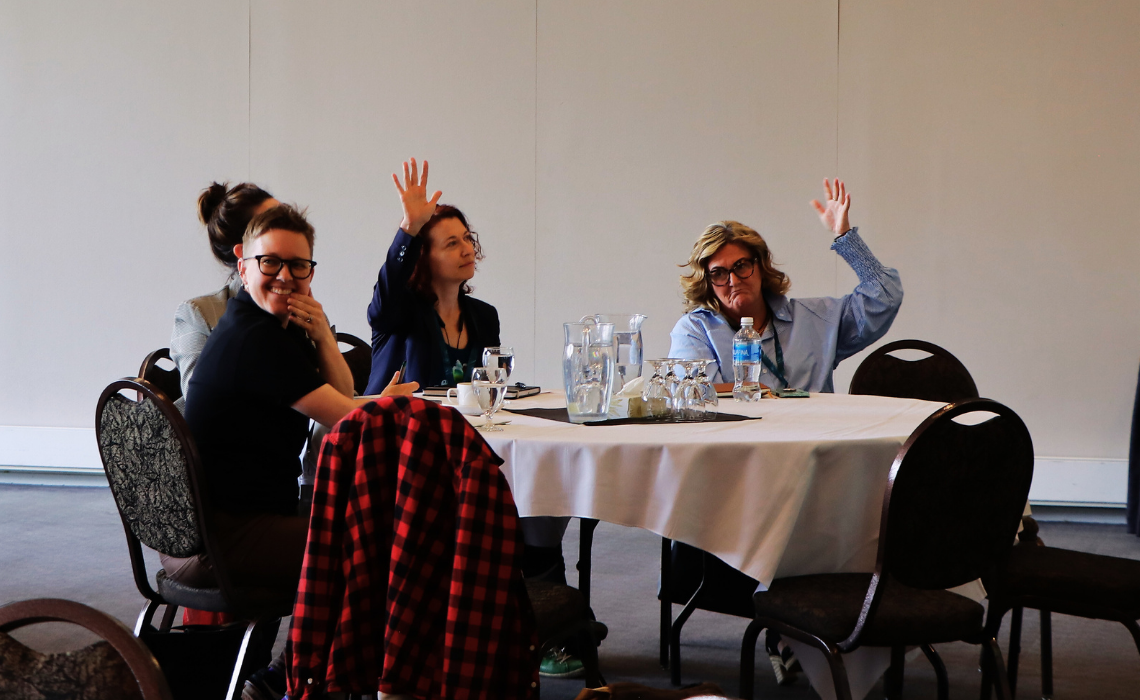
It’s time to upend that model. Rethinking collaboration means rethinking who gets to co-create outcomes and who gets to own them. It means moving beyond transactional relationships toward shared responsibility, from sporadic funding to systemic investment.
“If we want real collaboration, we have to share more than goals. We have to share power.” - Sarah Lamb and Annelies Tjebbes
So what would it look like to move from competition to co-creation? From scarcity to alignment?
These answers won’t come from the top down. They’ll emerge from the relationships we build, and the risks we’re willing to take together. The future of nonprofit–government collaboration isn’t just about securing a seat at the table. It’s about transforming the table itself so that nonprofits are not just invited, but equipped, empowered, and embedded as co-creators of the public good.
“Can we turn problems into assets? How can we ACTUALLY work together differently and embrace the messy middle.” - Christine Spottiswood
The Social Sides of the Systems
And it turns out, partnerships between nonprofits and governments, between organizations and institutions, aren’t so different from personal relationships.
Sarah Lamb and Annelies Tjebbes reminded us of that. They took us deeper into the systems stories, once again, as insiders, people who live and work within these systems every day.
Because systems aren’t just structures, they’re built on relationships. And in those relationships, the space between us often matters more than the policies above us. Systems don’t change just because we rewrite the policy. They change because people change as people begin to trust each other enough to try something new, to take risks, to stay in the discomfort together.
“Change won’t happen because things are urgent…or we need it to happen. It will happen because we take the time to build the relationships with people long-term.” - Geraldine Cahill
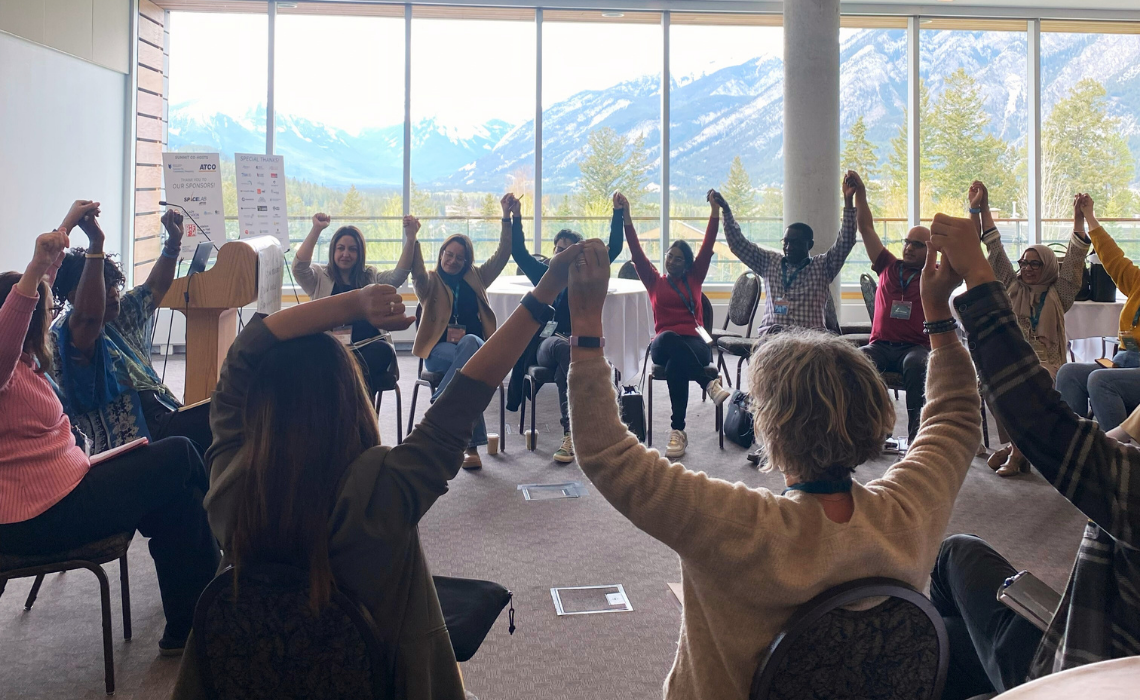
And trust? It doesn’t happen automatically. When people feel dismissed, uncertain, boxed in, or treated unfairly, they retreat, whether they’re individuals or entire organizations. Collaboration stalls. Energy leaves the room.
But when people feel seen, safe, and respected, when their status is acknowledged, their autonomy honored, their contributions valued, something real begins to shift. They lean in. They move toward one another. They take risks together.
That’s where the SCARF model - Status, Certainty, Autonomy, Relatedness, Fairness - came in. It helped name what often goes unnamed: the emotional undercurrents that either open the door to trust, or quietly close it.
“Meaningful systems change is relational work. It moves at the speed of trust.”
Power inherently lives in relationships, but it isn’t something to hold tighter. It’s something to share wider.
The shift we’re all being called into, not a new system, but a new way of being in relationship with each other.
Which leads us here:
The Accessibility Side of Systems
If systems are built on relationships, then who they’re built for, and who gets left out?
Accessibility is not a separate issue, an afterthought, a checklist or a legal requirement to meet once something is already built.
“Instead of asking what we lose with disability, let's ask ourselves what we gain from accessibility. Curb cuts and captions can benefit the masses! We're all going to get old or die trying, so working with disabled people now can help future-proof our world for aging.” - Keely Kidner
That’s the shift. Accessibility isn’t just about removing barriers but going above and beyond to reimagine what’s possible, not only to include more people, but to design from the start with difference in mind.
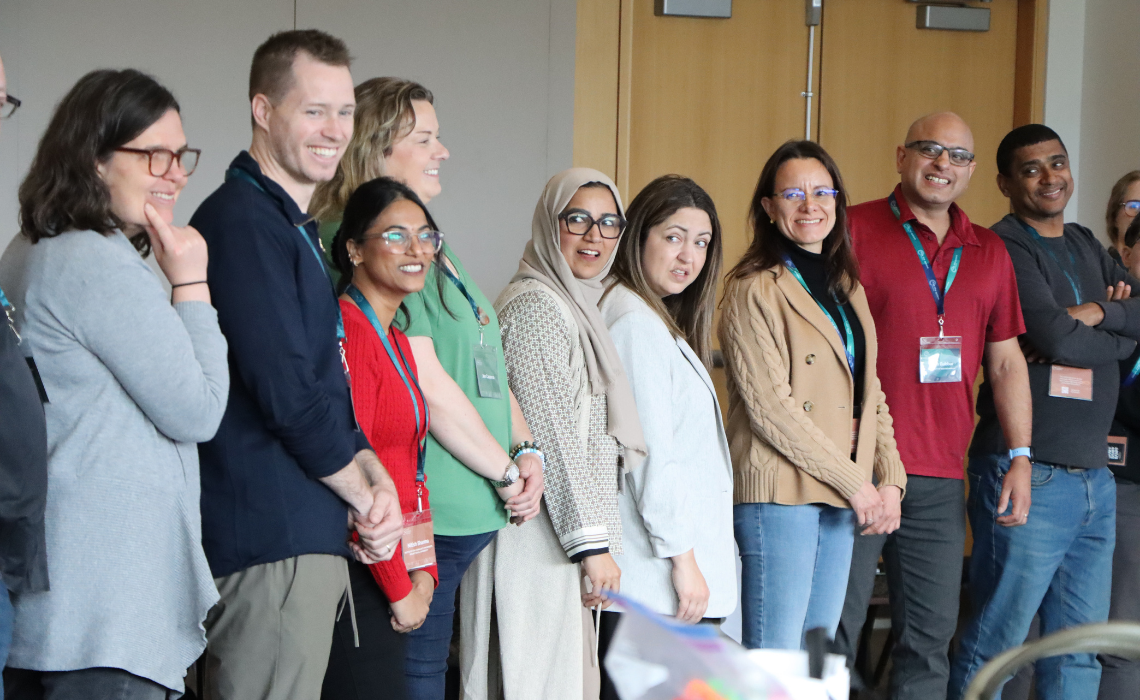
When we build systems this way, intentionally, universally, we not only create access, but we also create collective dignity and trust. We create spaces where people can show up as their full selves, not just the parts that fit the mold of dominance in the society, like ableism.
And thinking that way, accessibility emerges as a systems design challenge that pushes us to think differently about systems thinking, social innovation, and community prosperity.
In systems built for true belonging, real change and community prosperity can begin.
“We don't want to default to accommodations and alternatives. We need to be iterative and develop richly thought-out designs. We need to move from the why to the how.” - Matthew Shaw
The Land as Teacher
On the third day, we stepped out to let it land because systems don’t only live in institutions or logic models; they breathe in the spaces between us, in our habits of thought, and in the land beneath our feet.
And so, we walked. We moved. We made.
We entered a different kind of learning, engaging not just our intellects, but our senses, our stories, and our bodies. One that sees beauty as signal. One that trusts the heart as much as the head. And through it all, one thread kept weaving itself through our conversations:
Art is systems work. Art is for social change.
During the summit, artists and facilitators brought creative practice into the center of systems learning. Through music, storytelling, movement, and poetry, we were reminded that systems don’t only shift through logic, they shift through emotion, empathy, and imagination. Systemic change is not only strategic but relational, embodied, and emergent. It requires us to notice who’s missing, to feel when something’s off, and to be vulnerable enough to change course, even in public.
“Art gets you into your body in ways words never do,” said Stephanie Banszky during a session on embodied changemaking/ Artist as Changemaker.
“To be human is to move and be art," added Louie Fermor
“The power of story builds the bridge," echoed a participant
We heard how art has the ability to cross boundaries that policies can't. In spaces where language becomes a barrier or trauma clouds comprehension, a poem, a drawing, a moment of shared silence can do what data often fails to: open the heart, change the mind, build trust.
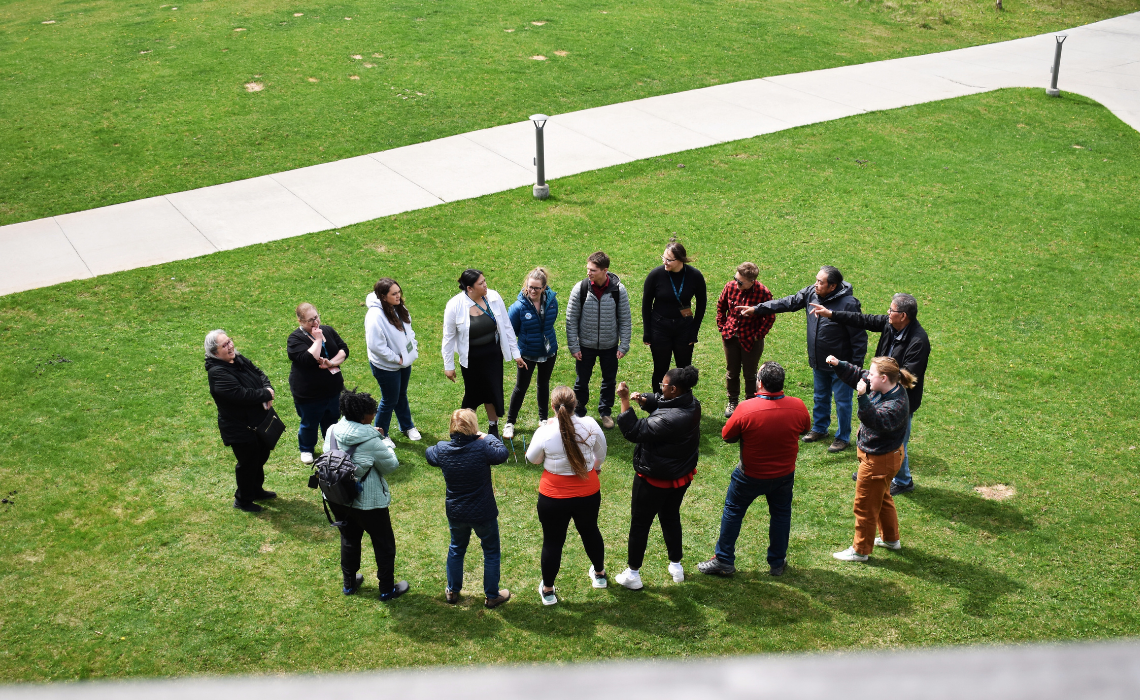
In Blackfoot Hand Games, participants didn't merely observe, they played. They laughed. They learned through rhythm and presence. In doing so, we understood what it means to learn in relationship, not transaction.
“Art makes space for ambiguity," one participant reflected. “And in complex systems, that’s exactly where insight lives."
At the Summit, art also gave us permission to pause, to reflect, to be vulnerable. Instead of rushing toward a “deliverable,” we were invited to express uncertainty, to play with possibility. And in that looseness, is a deeper embodied sense of what a different kind of system might feel like.
Art reminded us that systemic transformation isn't just a technical challenge but a cultural one. And culture is shifted through story, symbol, movement, and meaning-making.
So when we walked the mountain, when we played the games, when we shaped systems in LEGO and stories in silence, we were practicing a different way of knowing and moving with our bodies. We dissolved the rush to deliver solutions, but instead see each other beyond our roles, to remember that how we show up together is part of the system we’re trying to change.
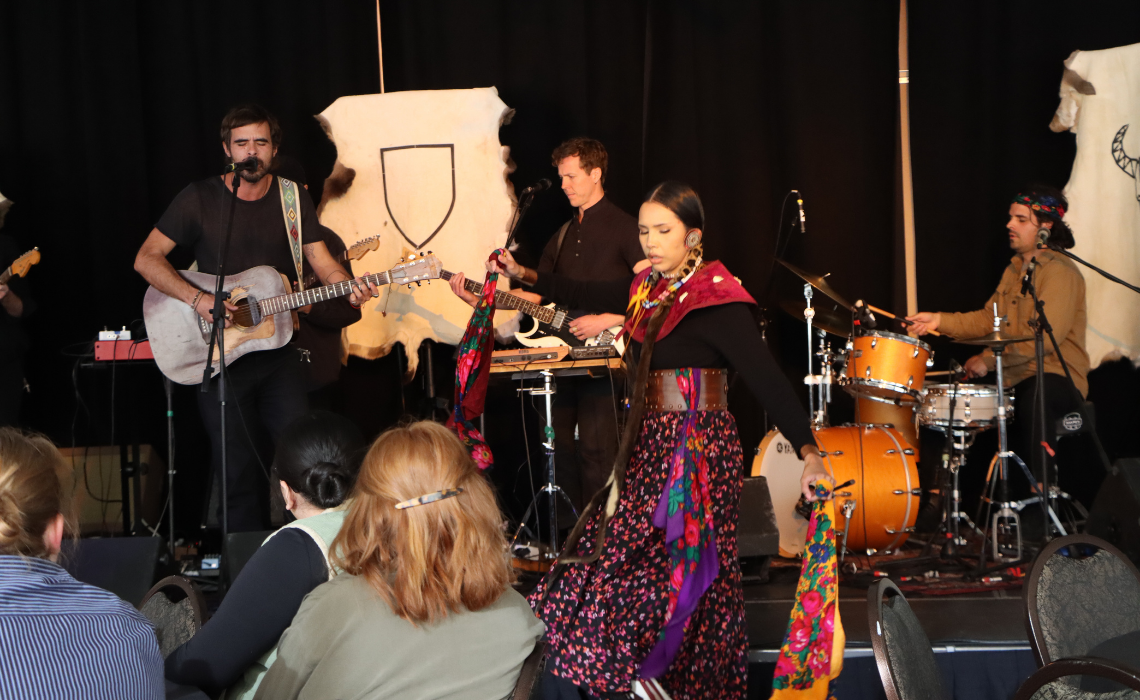
We built cranes out of paper and laughter, failing and recalibrating in real time. We shaped metaphors from LEGO bricks, where we embrace complex systems made tangible in bright plastic. We played Blackfoot Hand Games, learned rhythm through our hands, and let go of knowing to feel.
“Knowledge,” Roy Bear Chief said, “is also in rhythm, relationship, and presence.”
In the Complexity Dojo, Julian Norris invited us to see ourselves as complex systems: fluid, patterned, and shaped by context.
“You can’t solve problems from the same level of consciousness that created them,” he reminded us.
In the “Crane Chain” activity, a simple task, moving an origami crane through a production line, quickly spiraled into miscommunication, delay, and dysfunction. It mirrored the real-world dynamics of systems work: misaligned visions, invisible bottlenecks, and assumptions we didn’t know we were making.
“We quickly assumed the roles we were born into,” a participant reflected. “But what if we stopped to ask each other why we’re here?”
As we walked up Sleeping Buffalo Mountain in silence, we walked within them. We watched our breath cloud in the air, watched the trees do what they’ve always done: stand together, listen deeply, adapt. That afternoon, we didn’t find a path. We became one.
“There is no path,” Jean Boulton reminded us in her closing keynote. “We lay down the path in walking.”
What We Carry Forward
“Every moment is a matter of showing up. Of pausing, reflecting, and choosing again." - Lena Soots-Haley
By the end of the Banff Systems Summit, we carried with us a quiet shift in how we listened, how we asked questions, and how we held each other in complexity.
“Systems thinking alone isn’t enough, you must also practice system being." - A speaker
Because if systems are living, so must we be. Alive to nuance. Alert to power. Willing to be changed.
We talked about procurement and policy, yes. About funding models and trust. But what stayed with us were the stories, the connections, the beautiful questions, the challenge of our current way of knowing, and the gentle acts of courage. These are the signals of transformation— the emergent patterns of how people relate, imagine, and persist together.
“Forest roots are focused on nourishing the other trees around them. We need to do more of that in our society." - Roisin Dillon
We left Banff with the permission to go slow. To ask different questions. To stay curious. And to lay down a path not by just solving, but by walking together.
We are grateful to the 58 speakers who shared their insights in their sessions. While not all speakers are featured in this article, each one has deeply informed the lessons and narratives reflected here.
